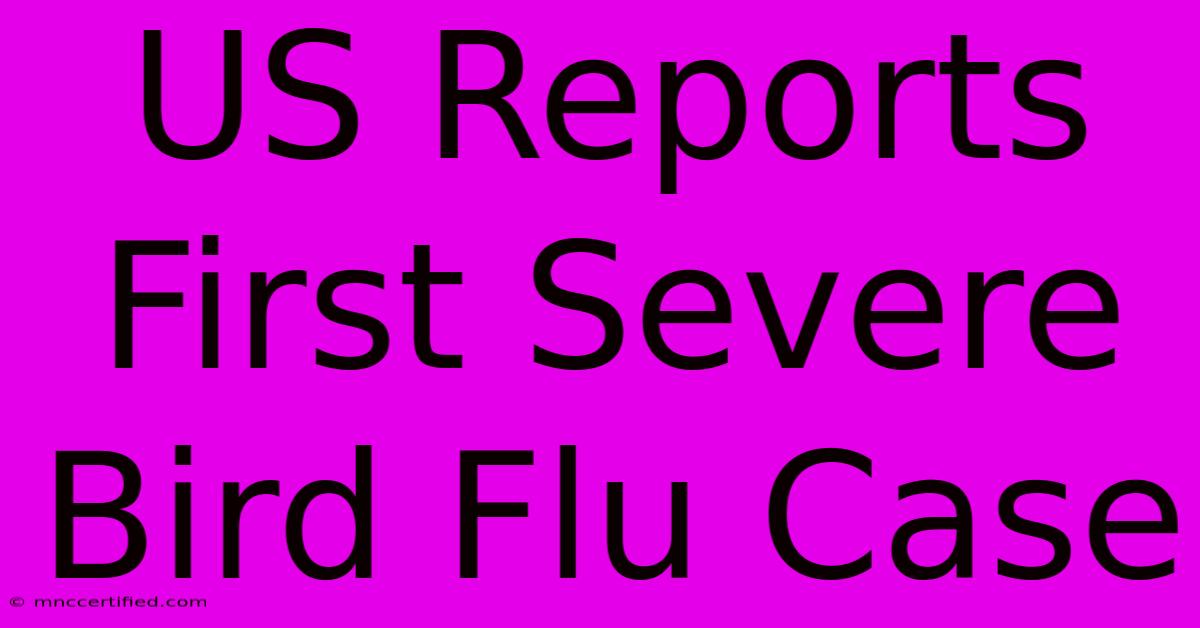US Reports First Severe Bird Flu Case

Table of Contents
US Reports First Severe Bird Flu Case: What You Need to Know
The United States has reported its first case of severe illness in a human caused by the highly pathogenic avian influenza (HPAI) virus, specifically the H5N1 subtype. This development underscores the ongoing threat of avian influenza and raises concerns about potential human-to-human transmission. While the risk to the general public remains low, understanding the situation is crucial. This article will delve into the details of this significant case, explore the potential risks, and outline the preventative measures individuals should take.
Understanding the H5N1 Bird Flu Virus
The H5N1 virus, a subtype of avian influenza, primarily affects birds. Outbreaks in poultry can lead to significant economic losses and culling of flocks. While human infections are relatively rare, they can be severe, even fatal. Transmission to humans typically occurs through close contact with infected birds or contaminated environments. This includes handling infected poultry, exposure to their droppings, or visiting live bird markets.
Key Differences from Previous Cases
This recent case differs from previous H5N1 infections in the US due to its severity. Past cases have often presented with milder symptoms. The specifics of this severe case, including the patient's condition and the extent of the infection, are still emerging and are subject to ongoing investigation by the CDC (Centers for Disease Control and Prevention). Transparency and prompt reporting are crucial in managing this evolving health situation.
The Severity of the Reported Case and Public Health Response
The severity of the reported case highlights the potential danger of H5N1, even in situations where direct exposure to infected birds might seem minimal. The CDC and other public health agencies are actively investigating the case to determine the exact circumstances of transmission and to assess the overall risk to the population. Rapid response and robust surveillance systems are vital in preventing wider outbreaks.
CDC Recommendations and Preventative Measures
The CDC continues to emphasize preventative measures to minimize the risk of infection. These include:
- Avoiding contact with birds: This includes wild birds and poultry, especially in areas with known outbreaks.
- Practicing good hygiene: Washing hands frequently with soap and water, especially after handling poultry or birds.
- Cooking poultry thoroughly: Ensuring that poultry is cooked to an internal temperature of 165°F (74°C) to kill the virus.
- Reporting sick birds: If you encounter sick or dead birds, contact your local animal control or wildlife agency.
The Risk to the General Public
While the risk to the general public remains low, the severity of this reported case warrants vigilance. The CDC is actively monitoring the situation and will provide updates as they become available. The possibility of human-to-human transmission remains a concern, but the current evidence suggests it is not easily spread between people.
Long-Term Implications and Future Research
This case underscores the importance of continued research into avian influenza viruses and the development of effective vaccines and antiviral treatments. International collaboration and data sharing are crucial for preparedness and global health security. Understanding the factors contributing to severe human infections is essential for implementing effective prevention strategies.
Conclusion: Staying Informed and Proactive
The emergence of a severe H5N1 case in the US serves as a reminder of the ongoing threat of avian influenza. Staying informed about the latest updates from reputable sources like the CDC and following recommended preventative measures are crucial in protecting public health. While the risk to the general public currently remains low, vigilance and proactive measures are essential to minimize any potential future threats. Continued monitoring and research are vital to mitigating the risk posed by H5N1 and other emerging infectious diseases.
Keywords: Bird flu, H5N1, avian influenza, US, severe illness, CDC, public health, pandemic preparedness, human infection, prevention, symptoms, risk assessment, viral infection, poultry, wild birds, health security, global health, infectious disease.

Thank you for visiting our website wich cover about US Reports First Severe Bird Flu Case. We hope the information provided has been useful to you. Feel free to contact us if you have any questions or need further assistance. See you next time and dont miss to bookmark.
Featured Posts
-
December 2024 Fed Rate Cut How Much
Dec 19, 2024
-
Tate Brothers Allegations Explained
Dec 19, 2024
-
Arsenal Vs Palace Carabao Cup Live Stream
Dec 19, 2024
-
New Site Chosen For Cal Anderson Memorial
Dec 19, 2024
-
Newcastle Vs Brentford Live Stream And Tv
Dec 19, 2024